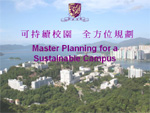Q: Why does CUHK need a Campus Master Plan (CMP)?
A: As a comprehensive research university, CUHK must have facilities in place to meet teaching and research demands. With the reversion to a four-year normative curriculum in 2012 and the adoption of a Strategic Plan which lays down the strategic directions for development in the next decade, the University needs a visionary CMP for the years leading up to 2021 and beyond. Q: Aedas Limited / Edward Cullinan Architects has been appointed to be the professional consultant for the CMP. Has the Committee selected the preliminary planning proposal submitted by them?
A: No, what the Steering Committee recommended was the team rather than the preliminary submissions, the latter being only a measure of the planning approach of the team and their capability. Their being selected does not mean the University has decided to adopt their preliminary planning proposal. Q: What is the timetable for the implementation of the CMP?
A: There are 4 different stages in our timetable. The 1st stage (18 weeks) involves inception field surveys, technical and planning assessment, and workshops to collect feedback from the University community. During the 2nd stage (12 weeks), views collected will be considered in the mapping out of planning principles and conceptual design of the CMP, while feedback will continue to be collected. The 3rd stage (18 weeks) involves the modification of the draft plan and to collect views on the proposed plan for further enhancement. The final CMP will be formulated during the 4th stage (6 weeks). There will be on-going communication with the University community throughout all the stages. Q: Some previous news reports state that the blueprint of the CMP does not include some buildings of historical value such as Ying Lin Tang, Ming Hua Tang and Hua Lien Tang. Does it mean that these buildings will be torn down?
A: Absolutely not. The University has not settled on any particular plan yet, nor have we requested or planned to tear down Ying Lin Tang, Ming Hua Tang and Hua Lien Tang. As a matter of fact, one of the guiding principles given to the 4 architectural teams is the "preservation of buildings on campus". The saying about tearing down certain college hostels must have arisen from mistaking some design concepts of the consultants to be the final decision of the University. Q: How will the Steering Committee ensure that the natural scenery, heritage buildings and tranquility of the University are not adversely affected by the proposed development?
A: There are committees set up under the Campus Planning Committee, including the Campus Landscaping Enhancement Committee, Standing Committee on Campus Geotechnical Matters and Building Committee (project specific), to ensure that a balance is maintained among the University's development needs, the safety of its community and the conservation and enhancement of its natural environment in all projects. When vetting campus development projects, these committees are also guided by the campus' existing Tree Preservation Policy. The University has drawn up policies and guidelines on trees preservation on campus and guarantees to plant more than one tree in compensation for every tree affected by capital works which cannot be transplanted. For latest news of CMP, please visit: http://www.cuhk.edu.hk/cmp. (Reference: Excerpted from The Chinese University of Hong Kong Campus Master Plan Press Conference on the Appointment of World-class Architect FAQ ) |


![]() 04 Mar 2008,
Issue 20
04 Mar 2008,
Issue 20



